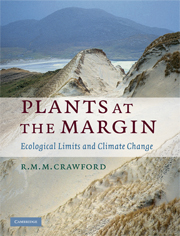Book contents
- Frontmatter
- Contents
- Preface
- Acknowledgements
- PART I THE NATURE OF MARGINAL AREAS
- PART II PLANT FUNCTION IN MARGINAL AREAS
- PART III MARGINAL HABITATS – SELECTED CASE HISTORIES
- 5 Arctic and subarctic treelines and the tundra–taiga interface
- 6 Plant survival in a warmer Arctic
- 7 Land plants at coastal margins
- 8 Survival at the water's edge
- 9 Woody plants at the margin
- 10 Plants at high altitudes
- 11 Man at the margins
- 12 Summary and conclusions
- References
- Author index
- Species index
- Subject index
5 - Arctic and subarctic treelines and the tundra–taiga interface
Published online by Cambridge University Press: 06 July 2010
- Frontmatter
- Contents
- Preface
- Acknowledgements
- PART I THE NATURE OF MARGINAL AREAS
- PART II PLANT FUNCTION IN MARGINAL AREAS
- PART III MARGINAL HABITATS – SELECTED CASE HISTORIES
- 5 Arctic and subarctic treelines and the tundra–taiga interface
- 6 Plant survival in a warmer Arctic
- 7 Land plants at coastal margins
- 8 Survival at the water's edge
- 9 Woody plants at the margin
- 10 Plants at high altitudes
- 11 Man at the margins
- 12 Summary and conclusions
- References
- Author index
- Species index
- Subject index
Summary
THE TUNDRA–TAIGA INTERFACE
Will climatic warming allow the boreal forest to advance onto the treeless tundra? This is one of the most tantalizing questions that can be asked in any discussion in relation to vegetation margins. The zone between the northern limit of the boreal forest (taiga) and the southern extent of the arctic tundra is the world's only circumpolar vegetation boundary and stretches for 13,400 km around the northern hemisphere and across three continents (Figs. 5.1–5.3). It is probably more exact to refer to this boundary as a zone, for in many places, and particularly in Russia, there is a well-developed interface region. This variable interface ecotone is best developed in Siberia where it is referred to by Russian ecologists as lesotundra (Russian les, forest). The term forest–tundra has also been adopted in describing similar ecotones or zones in eastern Canada created over the last 3000 years by deforestation as a result of the combined action of forest fires and climatic cooling (Asselin & Payette, 2005).
Such is the length of this boundary that it cannot be expected to have the same appearance or behave uniformly throughout its entire length. In some places it can be seen as a relatively abrupt change from forest to open tundra while in others, and particularly in Siberia, there is a lesotundra transition zone that can be several hundred kilometres deep.
- Type
- Chapter
- Information
- Plants at the MarginEcological Limits and Climate Change, pp. 161 - 196Publisher: Cambridge University PressPrint publication year: 2008



